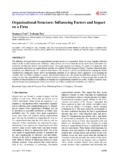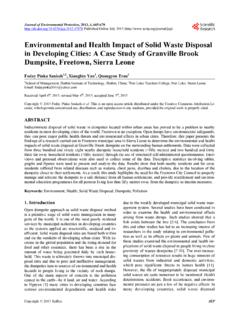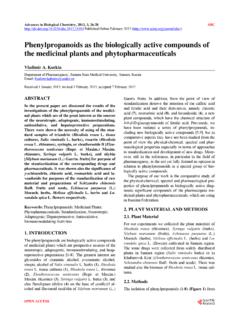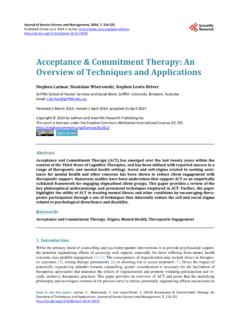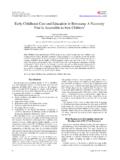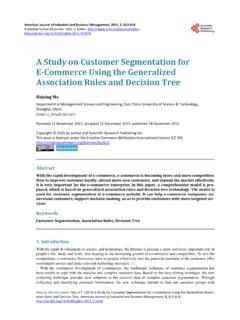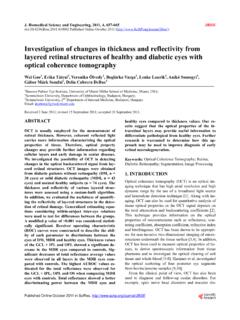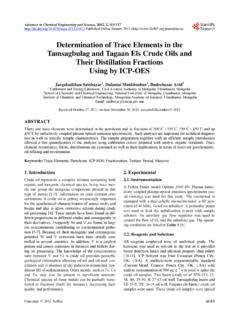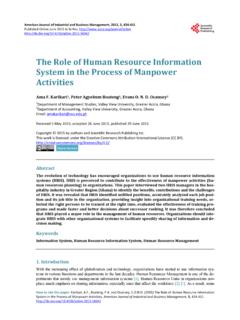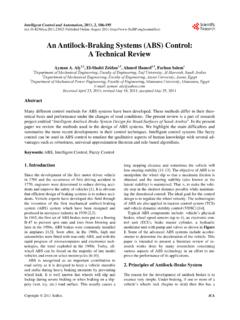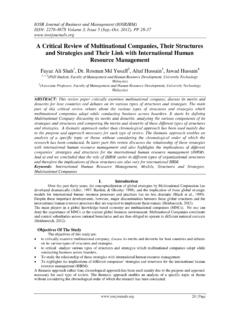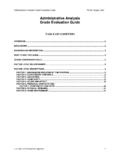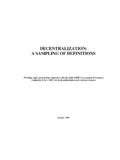Transcription of The Review of Empowerment Leadership
1 Open Journal of Business and Management, 2015, 3, 476-482 Published Online October 2015 in SciRes. How to cite this paper: Liu, (2015) The Review of Empowerment Leadership . Open Journal of Business and Manage-ment, 3, 476-482. The Review of Empowerment Leadership Yingying Liu School of Management, Jinan University, Guangzhou, China Email: Received 12 October 2015; accepted 26 October 2015; published 29 October 2015 Copyright 2015 by author and Scientific Research Publishing Inc. This work is licensed under the Creative Commons Attribution International License (CC BY). Abstract First, the paper starts with the meaning of power and Empowerment and discusses the concept of empowering Leadership . It summarizes the constructs and measuring instruments of empowering Leadership by literature analysis. Second, on the basis of empirical researches, it analyzes the an-tecedents and effectiveness as well as intervening factors.
2 Finally, it points out the limitations of current researches and some prospects for the future research. Keywords Leadership , Empowering Leadership , Antecedents, Effectiveness 1. Introduction Leadership is a hotspot in the field of management science. The earliest research that uses scientific method can be traced back to Leadership trait theory in the early 20th century [1]. And then, more researches on Leadership theory are sprung out, including four-graph theory of Ohio State University, Leadership system model theory of University of Michigan, situational Leadership theory, the path goal theory, two factor theory of transformational Leadership and transactional Leadership . In recent years, enterprises are facing profound technology and business revolution. These changes bring flat and centralized organization design, flexibility, customer orientation, the improvement of quality and efficiency. In addition, the nature of work has changed a lot.
3 It becomes more complex and demands more cognition. In-tellectual employee becomes the core of the quickly increasing labor. Under the background of such a change, the Empowerment Leadership is born as a special kind of leader. The concept of Empowerment Leadership was proposed in 1990s. Manz originally called Empowerment lea-dership as super Leadership [2]. Pearce extended Leadership theory and proposed four factor theory consisted of transformational Leadership , transactional Leadership , instrumental Leadership and Empowerment Leadership by exploring factor analysis [3]. And he confirmed its validity through confirmatory factor analysis with the third sample. So Empowerment Leadership could be isolated as an independent type of Leadership . Difference from Y. Y. Liu 477 tr aditional Leadership style, Empowerment Leadership emphasized the process of subodinate s self-influence in-stead of level control. 2. The Meaning of Empowerment Leadership Social Relationship Perspective According to social exchange theory, power is a concept that can reflect social concept.
4 It represents the inter-dependent social function and the asymmetric control of resources and results in the context of a particular situ-ation and social relations [4]. This definition implies two characteristics of power: controlling others and be in-dependent of others in order to achieve their goals. Power works as a control mechanism. The one who owns power can drive others to help them achieve their goals. In another word, power is the ability not influenced by others. A person will be subject to others without power and he will be relatively free with power. Power source can be the individual s ability to provide valuable resources to the organization. It can also be his position in the organization structure, professional skills and opportunity to access to specific knowledge or information, etc. From this perspective, Empowerment is a kind of resource allocation strategy that can reduce the dependence on high power. The Empowerment Leadership behavior can be defined as a series of management practices, in-cluding decentralization , participation, information sharing and training [5] [6].
5 Psychological Motivation Perspective In the psychological literature, power and control are used to describe the state of belief individual s internal motivation or expectation. For example, the individual is considered to have the need for power [6]. In another word, he has the internal need to influence and control others. Power and control have drawn many psycholo-gists attention. Their studies include internal/external control, acquisition, the main/secondary control. Individ-ual s power needs will be met when they perceive that they have power or they believe they can adequately handle life events, situations or people attached to them. On the other hand, when the individual feels that power is very low, or they think they cannot handle the physical or social requirements that are raised by the environ-ment, their power needs will not be met. Under the perspective of this research, power is related to an inner self- determining demand or a belief in individual self-efficacy [7].
6 Empowerment Leadership behaviors from this perspective include any management decision or technology that can improve employee s inner level of motivation by enhancing his self-determining demand or self-effi- ciency [8] [9]. Thomas believed that Empowerment was an improvement on the level of intrinsic motivation, and proposed the concept of psychological Empowerment [10]. Spreitzer explained employees perception of power as the four aspects of employee s perception of work meaning, self-efficacy, autonomy and influence [11]. 3. Construction and Measurement From these two theoretical perspectives, scholars have made different discussions on the structure and mea-surement method of the Empowerment Leadership . From the perspective of psychological Empowerment , Tho-mas proposed a cognitive model composed of sense of meaning, sense of competency, sense of autonomy and impact [10]. On the base of this model, Spreitzer developed a multidimensional scale of psychological empo-werment [11].
7 And he confirmed the validity of this four-dimension scale through the two-order confirmatory factor analysis. Using empirical research method, Li Chaoping et al. verified the applicability of Spreitzer s psychological Empowerment scale on the background of Chinese culture through twice questionnaire surveys on 23 companies [12]. And he examined Empowerment s impact on employee attitude with this scale. Ahearne di-vided the Empowerment Leadership behavior into four dimensions [8], and developed an Empowerment leader-ship scale on the basis of qualitative study of Conger [9] and empirical study of Hui and Thomas [13]. The scale has the high reliability with the internal consistency coefficient of From the perspective of management practice, Arnold explored the structure of Empowerment Leadership through a qualitative study and two quantitative studies [14]. Firstly, he commenced on a comprehensive inter-view of 195 people from three organizations, including external leaders and internal members and getting the preliminary dimension of Empowerment Leadership behavior.
8 Then he abstracted five factors of leading by ex-Y. Y. Liu 478 ample, participatory decision-making, counseling, information sharing and caring through questionnaire surveys, which was confirmed to have high validity by further cross validation. The Empowerment Leadership behavior questionnaire ELBQ established by Konczak contained 6 dimensions and 17 items [15]. The dimensions include decentralization of authority, emphasis on responsibility, encouraging independent decision-making, sharing in-formation, cultivating skills and encouraging innovation. The examination result showed that consistency coef-ficients ( - ) of all projects reach the standard. Wang Hui studied the dimension and measurement of Empowerment behavior in the context of Chinese enterprises using empirical research methods [16]. The content of Empowerment Leadership was divided into six dimensions: personal development support, process control, power appointment, results and target control, participative decision-making and work instruction.
9 In this study, Wang Hui developed an Empowerment Leadership scale consisted of 24 items. The structure validity of the scale was confirmed by a further confirmatory factor analysis, and the internal consistency analysis showed that the scale had a good reliability. In summary, the research on the structure and measurement of the Empowerment Leadership in foreign coun-tries is very rich. And the measurement is more in the form of questionnaire, which reflects leader s empower-ment behavior by subject report. Because of the huge difference between Chinese and Western culture, is the foreign scale suitable for the study of the organizational behavior in the context of Chinese culture. In recent years, although some domestic scholars have seen this difference and begun to explore the structure of the em-powerment Leadership under the situation of China, but the research number is relatively small. Nowadays the positive studies in our country mostly use the six -dimension scale developed by Pearce and Sims in 2000 which included encouraging self-reward, encouraging teamwork, participative goal setting, encouraging independent action, encouraging opportunity thinking and encouraging self-development.
10 So the future study should dedicate to make up for this shortage. To explore the most effective Empowerment Leadership behavior in different in-dustries under Chinese culture background and develop correspondent scale, laying foundation for future study. 4. The Antecedents of Empowerment Leadership The previous studies on the antecedents of Empowerment Leadership can be classified to four types: individual level factors (sex, personality, control desire), leader-subordinate relationship factors (trust, leader-member ex-change), organization level factors (organization system control) and culture factors (power distance, uncertainty avoidance). It was found that trust was the basis of Empowerment Leadership behavior [17]. Hakimi thought that leader s trust degree in subordinate s performance and integrity can positively predict Empowerment Leadership behavior which is moderated by responsibility of the big five personality [5]. Wei Huimin found that leader s cognitive trust and emotional trust in the subordinate are both helpful to increase the Empowerment Leadership behavior, in which cognitive trust has the greatest influence on the decision-making participation dimension of empower-ment behavior and emotional trust has the greatest influence on information sharing dimension and coach di-mension of Empowerment behavior [18].
